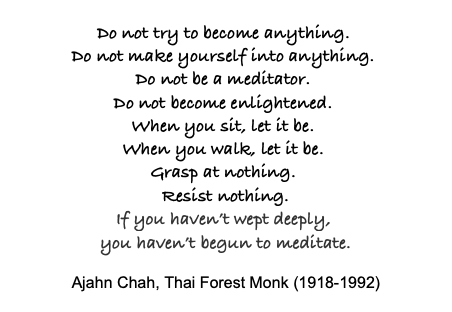
Ajahn Chah, Thai Forest Monk (1918-1992)
Thursday – A Day of Self-Discovery
Thursday finally arrived, a day I eagerly anticipated to pause everything and focus solely on understanding my personal journey. Another 2.5 hours of heightened awareness through practice and the exchange of experiences awaited me.
Week 2 continued to be a learning process, a delightful exploration into the unknown. There’s a certain pleasure in not knowing where you’re headed, trusting that it’s for the best.
How often do you embark on something positive without a clear idea of what the session will unfold?
For me, I chose to embrace the journey wholeheartedly and let myself be dedicated to whatever experience lay ahead.
What Did We Learn in Week 2?
The class kicked off with a meditation walk—a slow-paced stroll where attention was entirely on the sensation of each step. It’s an exercise in mindfulness, an act of feeling, embracing, enjoying, and even loving the gentle, deliberate pace we seldom indulge in.
Transitioning from a brisk walk to a slow one, we became mindful of others entering the room. Speeding up again felt intrusive, prompting reflections on our societal tendency for rapid, thoughtless actions. Slowing down felt not only nicer but also revealed the unnecessary haste in our lives.
The sensation of the ground beneath our feet was highlighted, reminiscent of the liberating feeling when walking barefoot on sand or grass. It’s a rejuvenating experience, reconnecting us with ourselves and recharging our inner battery.
The lesson extended to slowing down our thoughts, emphasising the importance of bringing them together.

From the 8 week course – https://evolvingminds.org.uk/
A Reflection on Past Experiences
Recalling a similar experience from my past, I remembered a time during my rehabilitation after a back injury. Learning to walk again, I intuitively understood that movement was key. After morning rehab exercises, physiotherapy, and pool sessions, I took slow walks in the hospital garden to rebuild confidence and readapt my body.
This journey laid the foundation for my current understanding of how the brain influences our bodies.
How Did I Fare with Homework?
Admittedly, despite my love for walking meditation, incorporating it into my week proved challenging. The knowledge that this tool is at my disposal whenever I need it provides comfort. Life in London can be frenetic, and as I approach 35, finding quality time becomes crucial.
While morning meditation didn’t suit my schedule, I made a habit of guided meditation at night before bed. It’s a flexible practice; sitting upright in bed sufficed, though caution is advised against getting too comfortable—I did nod off a couple of times!
Completing a pleasant audit log and a daily gratitude log proved fulfilling. Reflecting on positive aspects of the day, easily forgotten amid stress, was a gratifying exercise.
What to Take Out of It?
The key takeaway is to slow down, live, and feel. Emotions, signals from your body—they exist for a reason. Incorporate a practice to ease the pace when life becomes overwhelming. It’s a learning process; perfection doesn’t come immediately, but the journey is worth the exploration.
Much like love, you’ll know when it’s there.
I hope you enjoyed this post and that it sparked your curiosity about Cognitive Meditation. Feel free to share your thoughts or experiences in the comments—I’d love to hear from you!
Namaste.
